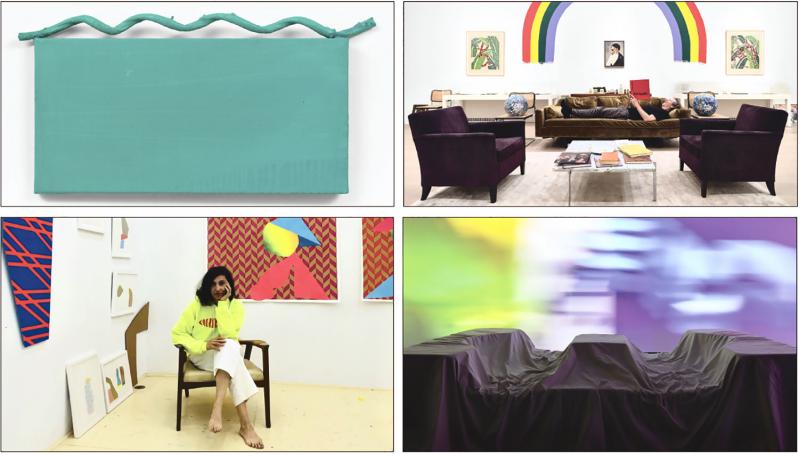Guild Hall’s summer exhibition schedule reflects both the interdisciplinary nature of the institution and the conviction of Melanie Crader, its museum director and curator of visual arts, that “artists’ creative output extends into every aspect of their lives. I think we’re all fascinated with how artists live and view the world.”
There will be paintings, works on paper, and ceramics, but there will also be furniture and two site-specific environments that will encourage the engagement of the public with both the environments and the artists themselves.
The museum will open on May 4 with a group exhibition, “Functional Relationships: Artist-Made Furniture,” and “Wading Room,” an environment created by Almond Zigmund. Both shows will run through July 13.
“Mary Heilmann: Water Way,” the artist’s first large-scale solo exhibition with an institution on the East End, and “Joel Mesler: Miles of Smiles,” an installation that mimics his studio, office, and exhibition space, will be on view from Aug. 3 through Oct. 26.
“Functional Relationships,” which uses Donald Judd as a historical reference, features East End artists who make functional furniture as an extension of their creative practice — as a means of problem-solving, to create an element of designed living, and to form social spaces — thereby incorporating art into many aspects of their daily lives.
“The furniture show is something I’ve wanted to do for a long time,” said Ms. Crader, who added that when she was applying for the job at Guild Hall she pitched the idea to Andrea Grover, its executive director. “We’re going to have a beautiful John Chamberlain couch that I saw in 2009 and I always think about it.” Made out of foam blocks, the couch is draped in parachute fabric.
The exhibition includes work by Scott Bluedorn, Liz Collins, Quentin Curry, Peter Dayton, Connie Fox, Kurt Gumaer, Ms. Heilmann, Yung Jake, Mark Wilson, Robert Wilson, Evan Yee, Nico Yektai, Ms. Zigmund, Judd, and Chamberlain.
While “Functional Relationships” will be a more traditional museum show insofar as the public will not be able to interact or touch the works, “Wading Room” is a different story.
“I tapped Almond to do a site-specific installation and also create an environment where we can have public participatory programs,” Ms. Crader said. The gallery will include Ms. Zigmund’s artworks on the walls, furniture she made, and furniture made by other artists. “One of the reasons I wanted to work with Almond was that, as the creator of the Artists and Writers dinners at Almond restaurant in Bridgehampton, I knew she would be really engaging and think of interesting public programs.”
One project will be a rug she will make and then invite the public to contribute to. The results will be visible at the end of the show. Another is Ms. Zigmund’s “wrap session,” for which members of the public are invited to bring objects they no longer need and then wrap them in such a way as to transform them into art objects. There will also be a collaborative drawing and design session.
“You’ll be able to sit down and use everything in ‘Wading Room.’ You’ll be able to have coffee there and be encouraged to stay and socialize,” Ms. Crader said.
Ms. Zigmund makes large-scale site-responsive installations, discrete sculptures, works on paper, and paintings. Combining crisp geometry, vivid color, and intricate patterns, her sculptures and installations often suggest walls, barricades, enclosures, and other aspects of the built environment.
“Mary Heilmann is an important figure not only in the art world but also in this area,” Ms. Crader said. “I could not be more proud to do this show, which is one she has always wanted to do.” The exhibition includes 40 paintings, drawings, and ceramic pieces linked by a focused area of her output — water.
Ms. Heilmann was born, raised, and educated on the coast of California before moving to New York City in 1968. She has had a house in Bridgehampton since 1995, bringing her once again into proximity to water. Whether as a direct image or as a referential title, water has long been a recurring theme in her work.
While some of the paintings in “Water Way” are clear references to waves, in other cases, such as “Psychedelic Night Wave,” it’s the title, rather than the image, that alludes to water. Some of the wall works are mixed-media, such as “Broken Wave,” from 2022, which consists of acrylic and papier-mâché pulp on wood and panel.
Referring to the mixed-media pieces and ceramics, Ms. Crader said, “She started out as a sculptor, so it makes sense that there are some three-dimensional elements to her work. And the ceramic pieces, which people aren’t as familiar with, are really beautiful.”
“Joel Mesler: Miles of Smiles” will be the artist’s first show at Guild Hall. He illuminates universal themes by filtering them through autobiography, humor, self-deprecation, and surprising compositional juxtapositions. He has explored the power of acceptance, allowing emotions — as well as the cultural forms in which they become entangled — to exist at the center of his projects.
“When I met Joel for a studio visit, we instantly connected and I asked if he would be interested in doing an installation here,” Ms. Crader said. The result, “Miles of Smiles,” will include work by a select group of his contemporaries. In addition to providing a gathering and meeting space, not unlike Ms. Zigmund’s, Mr. Mesler will hold office hours in order to interact with visitors.
Some of his public programs are still being worked out, but Ms. Crader mentioned Portrait Painting With Joel, Story Time With Joel, and Don’t Stop Painting as possibilities.
While he has an M.F.A. from the San Francisco Art Institute, he worked for many years as an art dealer in Los Angeles, New York, and, after moving to the East End in 2017, with the Rental Gallery in East Hampton.
The exhibitions have been organized by Ms. Crader with Philippa Content, the museum registrar and exhibition coordinator.




